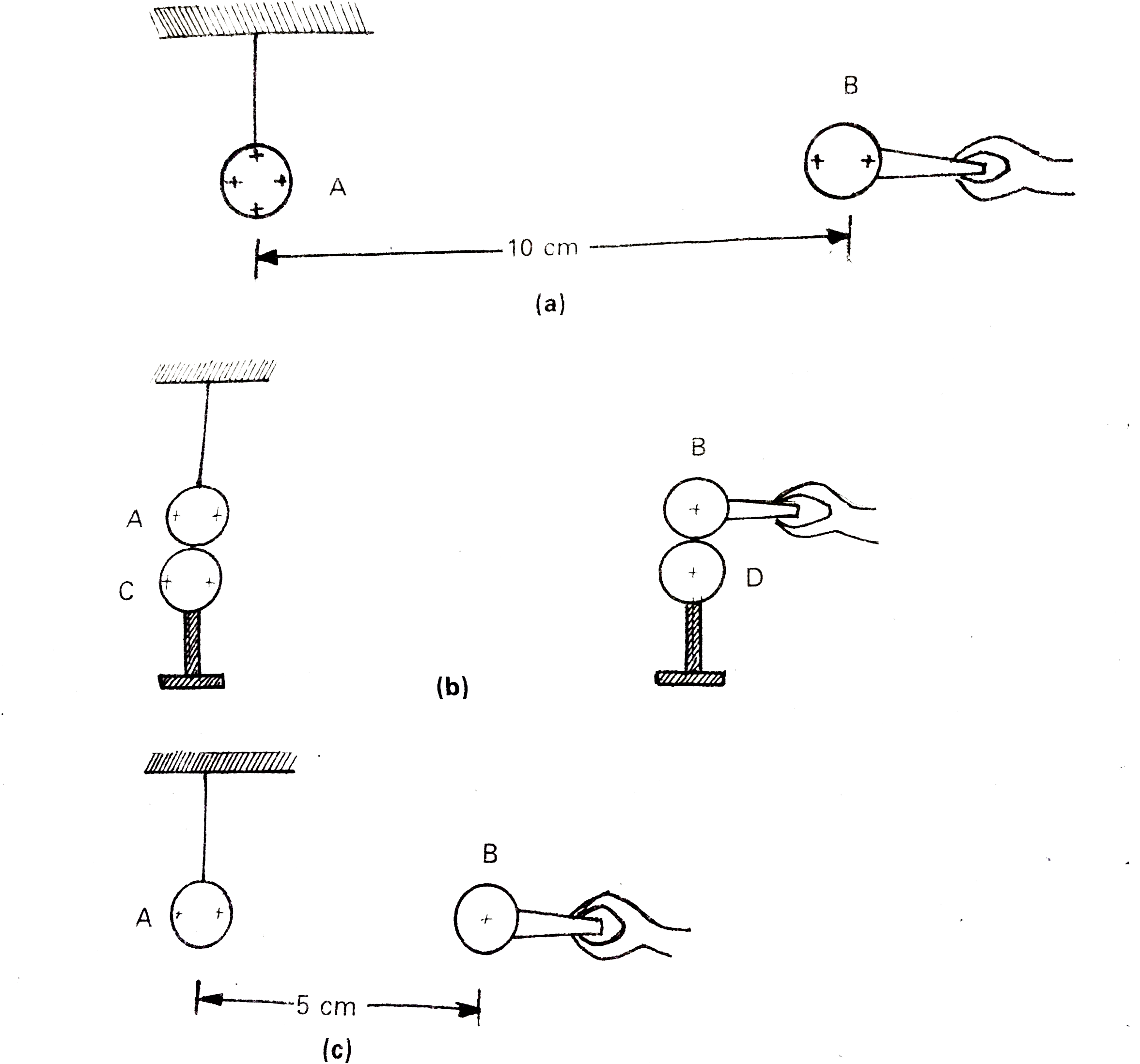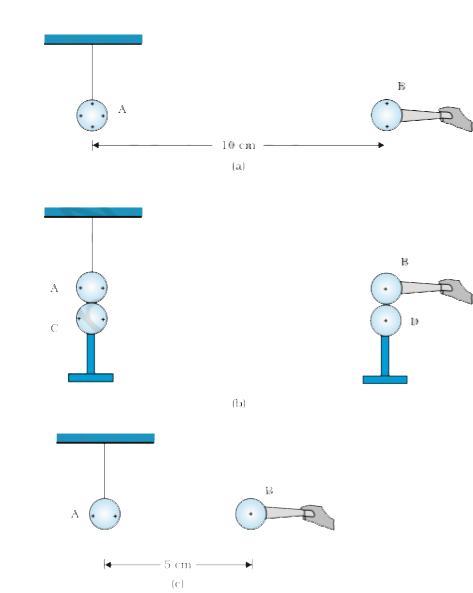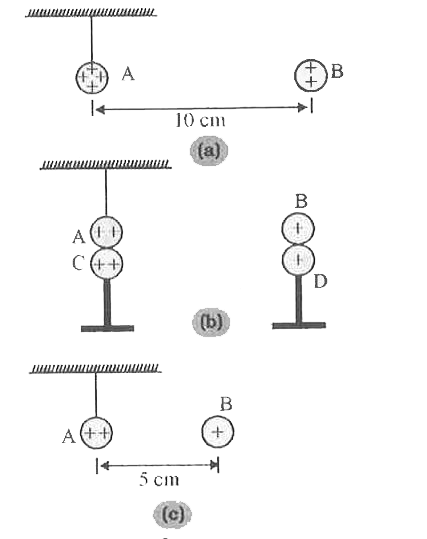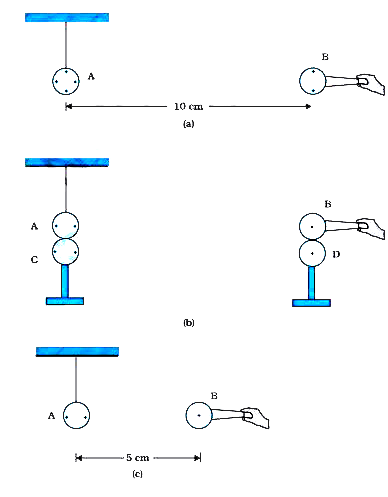A charged metalic sphere A is suspended by a nylon thread. Another charged metallic sphere B held by an insulating handle is brought close to A such that the distance between their centres is 10 cm, as shown in Fig. (a). The resulting repulsion of A is noted (for example, by shining a beam of light and measuring the deflection of its shadow on a screen). Spheres A and B are touched by uncharged spheres C and D respectively, as shown in Fig. (b). C and D are then removed and B is brought closer to A to distance of 5.0 cm between their centres, as shown in Fig. (c). what is the expected repulsion of A on the basis of Coulomb's law? Spheres A and C and spheres B and D have identical sizes. Ignore the size of A and B in comparison to the separation between their centres.
 Solution in Telugu
Solution in Telugu
Let the original charge on sphere A be q and that on B be q'. At a distance r between their centres, the magnitude of the electrostatic force on each is given by
F=14πε0qq'r2
Neglecting the sizes of spheres A and B in comparison to r. When an identical but uncharged sphere C touches A, the charges redistribute on A and C and by symmetry, each phere carries a charge q/2. Similarly, after D touches B, the redistributed charge on each is q'/2. Now, if the separation between A and B is halved, the magnitude of the electrostatic force on each is
F'=14πε0(q/2)(q'/2)(r/2)2=14πε0(qq')r2=F
Thus the electrostatic force on A, due to B, remains unaltered.
Topper's Solved these Questions
- BOOK - VIKRAM PUBLICATION ( ANDHRA PUBLICATION)CHAPTER - ELECTRIC CHARGES AND FIELDSEXERCISE - VERY SHORT ANSWER QUESTIONS13videos
ELECTRIC CHARGES AND FIELDS
- BOOK - VIKRAM PUBLICATION ( ANDHRA PUBLICATION)CHAPTER - ELECTRIC CHARGES AND FIELDSEXERCISE - SHORT ANSWER QUESTIONS6videos
ELECTRIC CHARGES AND FIELDS
- BOOK - VIKRAM PUBLICATION ( ANDHRA PUBLICATION)CHAPTER - DUAL NATURE OF RADIATION AND MATTEREXERCISE - DAM SURE (VSAQ)2videos
DUAL NATURE OF RADIATION AND MATTER
- BOOK - VIKRAM PUBLICATION ( ANDHRA PUBLICATION)CHAPTER - ELECTROMAGNETIC INDUCTION EXERCISE - Additional EXERCISES15videos
ELECTROMAGNETIC INDUCTION
Similar Questions
What is meant by the statement 'charge is quantized' ?
03:13View SolutionState and explain Coulomb's incerse square law in electricity.
02:59View SolutionThe wavelength of electromagnetic radiation is doubled. What will happen to the energy of the photons of the new radiation ?
02:59View SolutionSuppose the loop in Textual Exercise 4 is stationary but the current feeding the electromagnet that produces the magnetic field is gradually reduced so that the field decreases from its initial value of 0.3 T at the rate of 0.02Ts−1 .If the cut is joined and the loop has a resistance of 1.6Ω how much power is dissipated by the loop as heat ? What is the source of this power ?
05:29View SolutionA metal sphere is suspended from a nylon thread. Initially, the metal sphere is uncharged. When a positively charged glass rod is brought close to the metal sphere, the sphere is drawn towards the rod. But if the sphere touches the rod, it suddenly flies away from the rod. Explain, why the sphere is first attracted then repelled?
06:27View SolutionA charged metallic sphere A is suspended by a nylon thread. Another charged metallic sphere B held by an insulating handle is brought close to A such that the distance between their centres is 10 cm, as shown in Fig. 1.7(a). The resulting repulsion of A is noted (for example, by shining a beam of light and measuring the deflection of its shadow on a screen). Spheres A and B are touched by uncharged spheres C and D respectively, as shown in Fig. 1.7(b). C and D are then removed and B is brought closer to A to a distance of 5.0 cm between their centres, as shown in Fig. 1.7(c). What is the expected repulsion of A on the basis of Coulomb’s law? Spheres A and C and spheres B and D have identical sizes. Ignore the sizes of A and B in comparison to the separation between their centres.
 02:01View Solution
02:01View SolutionA charged metallic sphere A is suspended by a nylon thread. Another charged metallic sphere B held by an insulating handle is brought close to A such that the distance between their centres is 10 cm, as shown in Fig. 1.7(a). The resulting repulsion of A is noted (for example, by shining a beam of light and measuring the deflection of its shadow on a screen). Spheres A and B are touched by uncharged spheres C and D respectively, as shown in Fig. 1.7(b). C and D are then removed and B is brought closer to A to a distance of 5.0 cm between their centres, as shown in Fig. 1.7(c). What is the expected repulsion of A on the basis of Coulomb’s law? Spheres A and C and spheres B and D have identical sizes. Ignore the sizes of A and B in comparison to the separation between their centres.
 05:27View Solution
05:27View SolutionThree metal spheres A,B and C are mounted on insulating stands. The spheres are touching one another, as shown in the diagram A strong positively charged object it brought near sphere A and a strong negative charge is brought near sphere C. While the charged objects remains near spheres A anc C, sphere B is removed by means of its insulating stand. After the charged objects are removed, sphere B is first touched to sphere A and then to sphere C. The resulting charge on B would be-
02:08View Solutionधातु का आवेशित गोला A नायलॉन के धागे से निलंबित है। विद्युतरोधी हत्थी द्वारा किसी अन्य धातु के आवेशित गोले B को A के इतने निकट लाया जाता है कि चित्र (a) में दर्शाए अनुसार इनके केंद्रों के बीच की दूरी 10cm गोले के परिणामी प्रतिकर्षण को नोट किया जाता है (उदाहरणार्थ-गोले पर चमकीला प्रकाश पुंज डालकर तथा अंशांकित पर्दे पर बनी इसकी छाया का विक्षेपण मापकर)। A तथा B गोलों को चित्र (b) में दर्शाए अनुसार क्रमशः अनावेशित गोलों C तथा D से स्पर्श कराया जाता है। तत्पश्चात् चित्र (c) में दर्शाए अनुसार C तथा D को हटाकर B को A के इतना निकट लाया जाता है कि इनके केंद्रों के बीच की दूरी 5.0 cm हो जाती है। कूलॉम नियम के अनुसार A का कितना अपेक्षित प्रतिकर्षण है? गोले A तथा C एवं गोले B तथा D के साइज सर्वसम हैं। A तथा B के केंद्रों के पृथक्कन की तुलना में इनके साइजों की उपेक्षा कीजिए।
 06:27View Solution
06:27View Solutionधातु के एक गोले A पर +10μC आवेश है। इसे दूसरे समान गोले B से स्पर्श कराया जाता है। गोले A पर कितना आवेश रह जायेगा ?
View SolutionThe weight of each of two small metal spheres having same amount of charge is 3g. The two spheres are suspended with tow threads of length 13 cm each from a point. Due to mutual repulsion they are at rest at a distance of 10 cm. Determine the charge on each sphere and tension in the threads.
04:24View SolutionThe mass of a metal sphere charged with +20 esu is 2g. Another smaller sphere with -128 esu of charge is suspended with a thread. The former sphere, just below this smaller one, is at rest. What is the distance between the centres of the two spheres? g="980 cm . s"^(-2)
04:07View Solutionधातु का आवेशित गोला A नायलॉन के धागे से निलंबित है। विद्युतरोधी हत्थी द्वारा किसी अन्य धातु के आवेशित गोले B को A के इतने निकट लाया जाता है कि चित्र (a) में दर्शाए अनुसार इनके केंद्रों के बीच की दूरी 10cm गोले के परिणामी प्रतिकर्षण को नोट किया जाता है (उदाहरणार्थ-गोले पर चमकीला प्रकाश पुंज डालकर तथा अंशांकित पर्दे पर बनी इसकी छाया का विक्षेपण मापकर)। A तथा B गोलों को चित्र (b) में दर्शाए अनुसार क्रमशः अनावेशित गोलों C तथा D से स्पर्श कराया जाता है। तत्पश्चात् चित्र (c) में दर्शाए अनुसार C तथा D को हटाकर B को A के इतना निकट लाया जाता है कि इनके केंद्रों के बीच की दूरी 5.0 cm हो जाती है। कूलॉम नियम के अनुसार A का कितना अपेक्षित प्रतिकर्षण है? गोले A तथा C एवं गोले B तथा D के साइज सर्वसम हैं। A तथा B के केंद्रों के पृथक्कन की तुलना में इनके साइजों की उपेक्षा कीजिए।
 07:23View Solution
07:23View SolutionA charged metallic spere A is suspended by a nylon thread another charged metallic spere b held by an insulating centres is 10 cm c and d are then removed and b is brought closer to a to a what is txpectd repulsion of a on the basis of columb law sphere a and c speres b and d have indentical sizes ignore the sizes of a and b in comparision to the separation between their centres
 View Solution
View SolutionA charged metallic sphere A is suspended by a nylon thread another charged metallic sphere b held by an insulating centers is 10 cm as shown in Fig. 1.7(a). The resulting repulsion of A is noted (for example, by shining a beam of light and measuring the deflection of its shadow on a screen). Spheres A and B are touched by uncharged spheres C and D respectively, as shown in Fig. 1.7(b). C and D are then removed and B is brought closer to A to a distance of 5.0 cm between their centers, as shown in Fig. 1.7(c). What is the expected repulsion of A on the basis of Coulomb’s law? Spheres A and C and spheres B and D have identical sizes. ignore the sizes of a and b in comparison to the separation between their centers
 05:15View Solution
05:15View Solution

